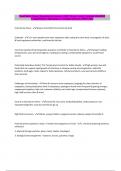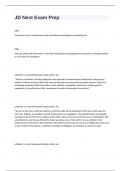Food Safety Exam | Questions & Answers (100 %Score) Latest Updated 2024/2025
Comprehensive Questions A+ Graded Answers | 100% Pass
Food borne illness - ✔️✔️disease transmitted to humans by food
Outbreak - ✔️✔️2 or more people have same symptoms after eating the same food, investigation of state
& local regulatory authorities, confirmed by lab test
Common reported food preparation practices contribute to food borne illness - ✔️✔️improper holding
temperatures, poor personal hygiene, inadequate cooking, contaminated equipment, unsafe food
source
Potentially hazardous foods ( TCS: Temperature Control for Safety Foods) - ✔️✔️high-protein, low acid
foods that can support rapid growth of infectious or disease causing microorganisms: milk/milk
products, shell eggs, meats, baked or boiled potatoes, tofu/soy products, raw seed sprouts (alfalfa or
bean sprouts)
Challenges to food safety - ✔️✔️time & money to train employees, language & culture barriers of
employees, literacy/education level of employees, pathogens found more frequent & getting stronger,
unapproved suppliers, high-risk customers (elderly, pre-school age, compromised immune systems),
high staff turnover (hire & train)
Costs $ to food borne illness - ✔️✔️human life, loss work, medical/disability, media exposure, loss
reputation/legal fee, insurance premiums go up
High Risk Consumers - ✔️✔️infants, young children, pregnant women, elderly, people chronically ill
Food becomes hazardous 3 ways ~ harmful microorganisms in food - ✔️✔️1. chemical (cleaning solutions,
sanitizers)
2. physical (foreign particles: glass, metal, staples, bandages)
3. biological (microorganisms ~ bacteria, viruses, parasites, fungi)
, Cross-Contamination - ✔️✔️transportation of harmful substances to food by: hands (touch raw meat ~
then ready to eat foods), surfaces (cutting boards, cleaning cloths), raw or contaminated foods (drip
fluids on cooked ready to eat foods), poor personal hygiene (wash hands after restroom, cough/sneeze,
touch or scratch face, do NOT work while sick)
Viruses - ✔️✔️microorganism ~ cause of food borne illness, need living host to grow, can survive for short
time on door handles, etc..., can be resistant to extreme heat/cold
Hepatitis A - ✔️✔️virus contacted by fecal oral route, found in ready to eat foods, shellfish, contaminated
water. Use good hygiene, exclude workers who are sick: vomiting, diarrhea, workers who have been
diagnosed
Norovirus - ✔️✔️airborne in vomit particles; Use good hygiene, exclude workers who are sick: vomiting,
diarrhea, workers who have been diagnosed
Parasites - ✔️✔️need to live in a host; pork (trichinosis); fish (roundworm~Anisakis); purchase from
reputable approved supplier, cook at correct temperature, seafood frozen correctly
Fungi - ✔️✔️molds produce dangerous toxins in food
Bacteria - ✔️✔️greatest threat to food, grow quickly at favorable temperatures. Some bacteria useful:
cheese, buttermilk, sauerkraut, pickles, yogurt. OTHERs are infectious disease-causing agents =
pathogens Bacteria can double every 10-30 minutes. Two become four, four become eight, etc.... A
single cell can become billions in 10-12 hours.
Botulism - ✔️✔️improperly canned foods, temperature abused veg., meats, sausage, fish
Escherichia Coli (E Coli) - ✔️✔️found in cattle intestines, raw & undercooked ground beef, raw milk, alfalfa
sprouts, unpasteurized fruit juices, lettuce, spinach
Listeriosis - ✔️✔️contaminated soil/manure, vegetables, unpasterized milk and dairy, raw meat, ready to
eat foods, deli meats





